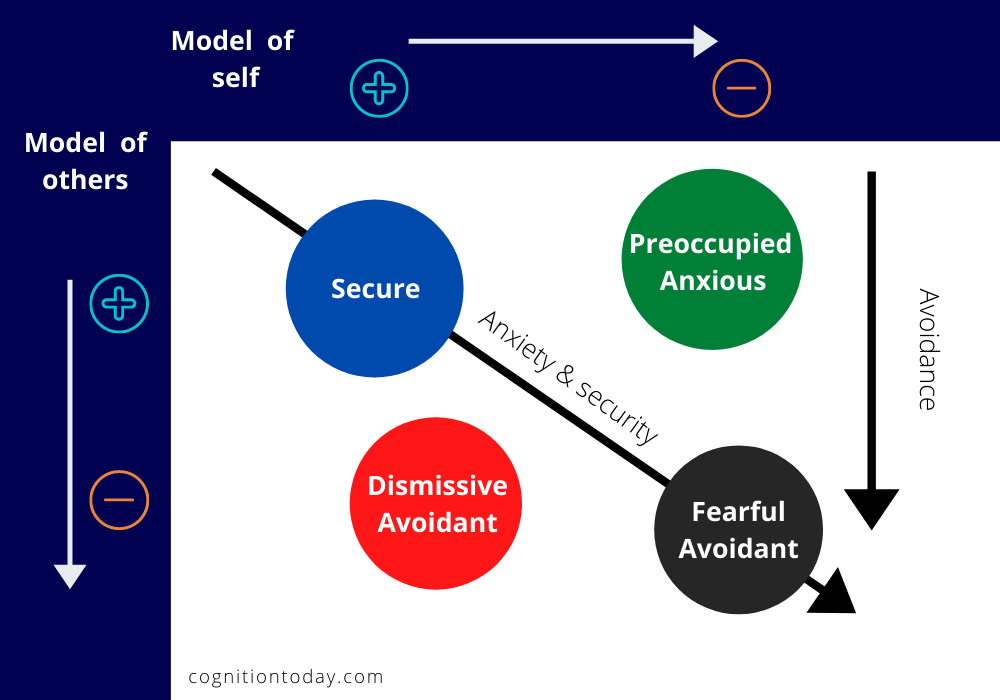Do you sometimes wonder how some of your friends feel calm and secure in their relationships with others, while another friend can’t seem to get rid of their FOMO? Or do you ask yourself, “Why do all my relationships crash and burn the same way?”
Attachment theory, as applied to adult relationships, provides a framework to understand individual differences in interpersonal experiences. Attachment theory talks about “the propensity of human beings to make strong affectional bonds to particular others.”
According to adult attachment theorists, people develop cognitive representations, or internal working models, that include generalized expectations, beliefs and attitudes, and goals about the self, others, and the relation between the two. These working models guide how people perceive, interpret, and respond to their social interactions.
Mary Ainsworth defined attachment as “an affectional tie that one person or animal forms between himself and another specific one- a tie that binds them together in space and endures over time.” Attachment is closely related to another concept in psychology called the self-construal theory. Specifically, the relational interdependent self-construal. I highly recommend reading that as well.
How attachment was observed in infants
John Bowlby, a pioneer of the attachment theory, placed great emphasis on attachment between infants and their mothers. He believed that the more time a child spends with his mother, the better it is for the child.
As a kid, Bowlby had a nanny to whom he was quite attached, but she left the family’s employ when he was four years old. Bowlby’s life work focused on the effects of early separation and loss on life-span development. Some believe his own childhood experiences drove his professional interest and gave him tremendous sensitivity to young children’s suffering.
Meanwhile, Mary Ainsworth, a developmental psychologist, found that it is not just spending time with the infant that is important but also the quality of care that is provided.
Ainsworth concluded that methods of care varied with culture and affected these relationships as well. She noticed that mothers separated from their husbands or families experienced more stress and seemed to pass it on to their infants.
Magda Gerber, an early childhood educator, highlights how parents should treat children respectfully. She emphasized that infants believe they are safe and competent when they have adults who can feel that way themselves. So Gerber suggested that parents ought to “do less and observe more.”
Inner workings of the adult attachment theory
Adult attachment theory[1] is an extension of Bowlby’s theory of the bonds between infants and their caregivers. The goal of attachment is to achieve ‘felt security.’ To serve this goal, children are thought to use their daily experiences to develop internal working models about their attachment figures’ availability and responsivity as well as their own worth in the eyes of their attachment figures.
Hazan and Shaver (1987) built on Bowlby and Ainsworth’s theories of infant-caregiver attachment and included adult romantic relations in it. This extension looked at three styles of behavior: secure, avoidant, and anxious (or anxious ambivalent). Several studies on Hazan and Shaver’s descriptions suggest two core factors of attachment: comfort with closeness and relationship anxiety.
Collin and Read (1990)[2] later developed the Revised Adult Attachment Scale (from the Adult Attachment Scale) based on Hazan and Shaver’s descriptions. It assesses three core factors (instead of the previous 2): closeness, anxiety, and dependency. Closeness and dependency are clubbed together to estimate a person’s avoidance level and anxiety measures just that – anxiety level. High-low scores on those 2 dimensions are used to categorize individuals into four attachment styles. So a two-dimensional construct gives us four attachment styles: secure, preoccupied, dismissing, and fearful.
To compare these attachment styles, it helps to look at 3 concepts together – Bowlby’s internal working models and Collin and Read’s Anxiety and Avoidance level.
- Anxiousness level – Your level of anxiety and insecurity with a partner or group.
- Avoidance level – Your tendency to stay distant or push intimacy and closeness away. Measures closeness and dependency.
- Internal working models
- Model of self – Do you see yourself in a positive way? A negative model means you see yourself as not-good-enough, unworthy, or have low self-esteem/self-worth.
- Model of others – Do you see others in a positive or negative way? A negative model means you see others as inadequate or unworthy.

So by combining all of these factors, according to the Adult Attachment model[3], we get 4 styles of how people attach to other people: Secure attachment, Preoccupied-Anxious attachment, Dismissive-Avoidant attachment, and Fearful-Avoidant attachment.
The 4 Attachment styles
1. Secure attachment
Indicates a sense of worthiness (lovability) plus an expectation that other people are generally accepting and responsive.
Characteristics and traits of people with a secure attachment style
- Confident and reciprocal
- Non-reactive
- Resilient
- Positive model of self and others
- Experience low anxiety and avoidance in the context of relationships
2. Preoccupied-Anxious attachment
Indicates a sense of unworthiness (unlovability) combined with a positive evaluation of others. This combination of characteristics would lead the person to strive for self-acceptance by gaining the acceptance of valued others. Also known as the Anxious type.
Characteristics and traits of people with a preoccupied or anxious attachment style
- Overly invested and involved in close relationships
- Dependent on others for self-worth
- Demanding, needy approach towards others
- Have a negative model of self, and a positive model of others
- High anxiety and low avoidance in relationships

3. Dismissive-Avoidant attachment
Indicates a sense of love-worthiness combined with a negative disposition toward other people. Such people protect themselves against disappointment by avoiding close relationships and maintaining a sense of independence and invulnerability.
Characteristics and traits of people with a Dismissive (or avoidant) attachment style
- Compulsively self-reliant
- Distant in relationships
- Downplays importance of intimate relationships
- Positive model of self and negative model of others
- High on avoidance and low on anxiety
4. Fearful-Avoidant attachment
Indicates a sense of unworthiness (unlovability) combined with an expectation that others will be negatively disposed (untrustworthy and rejecting). By avoiding close involvement with others, this style enables people to protect themselves against anticipated rejection by others.
Characteristics and traits of people with a fearful attachment style
- Dependent on others, but avoid intimacy due to fear of rejection
- Low self-esteem
- High anxiety attachment
- Negative model of self and others
- High on anxiety and avoidance
How are attachment styles formed?
Humans have a biological predisposition for social interaction. As infants, we instinctively seek proximity to our caregivers. These early caregiver-infant interactions give rise to caregiver-infant attachment[4], which influences biological and psychological processes by changing the brain’s sensitivity to thoughts, emotions, and behaviors. Early social interactions between caregivers and infants influence the infants’ cognitive and socio-emotional development. And subsequently, the development of social, familial, and romantic relationships later in life. Caregiver-infant attachment shapes the activation of neural pathways[5] involved in socio-emotional regulation.
Our life experiences shape the way we attach ourselves to others. Remember how Ross from FRIENDS got very insecure in his relationship with Rachel after his ex-wife Carol left him for another woman?
Harville Hendrix, the author of Getting the Love You Want[6]*, believes that our attachment style depends on the parenting style we experienced as infants. According to his push and pull theory, parents who push children away raise children with an insatiable need for closeness (anxious) and parents who smother their children and never let them explore, raise children who crave personal space (avoidants).
How do our attachment styles affect our everyday lives?
Attachment styles exert a broad influence on emotional experiences. They not only influence our relationships but also predict our emotions, cognitive appraisals (mental assessment), daily experiences, or the type of interpersonal problems we might encounter.
A study on undergraduate students[7] suggests that those holding a secure style reported greater feelings of happiness, more positive self-appraisals, viewed their current situation more positively, felt more cared for by others, and felt closer to the people they were with. These findings are consistent with previous work[8] showing that secure attachment is associated with a sense of self-efficacy, optimistic appraisals toward life in general, as well as positive interpersonal attitudes.
In their ESM study on ‘Daily Experiences of Emotions and Social Contexts of Securely and Insecurely Attached Young Adults,’ Torquati and Raffaelli (2004)[9] found that both when in the presence of familiar intimates and when alone, the secure group reported higher levels of emotions relating to energy and connection than the insecure group. Additionally, when alone, securely attached individuals reported greater levels of positive affect than insecurely attached individuals; participants with a secure style endorsed more extreme positive emotional states across all social contexts, whereas those with insecure styles endorsed more extreme negative emotional states, particularly when they were alone.
Each style of attachment encounters a different interpersonal problem[10]. Fearful people are more likely to experience problems with interpersonal space, or experience helplessness when forming new relationships. Dismissing people are more likely to report problems related to a lack of warmth in social interactions, or difficulty in being intimate with others. Preoccupied people are highly dependent on others to maintain positive self-regard, they attempt to achieve this aim through a controlling (overly dominating) interpersonal style and are likely to report problems related to sensitivity to outside threats or fear of being abandoned.
Can attachment style change or evolve with time?
Exploring your own attachment style may be overwhelming, but it does not have to be. Your attachment style is not something you are stuck with, it is something that evolves with each new life experience, and if you’re up for it, some conscious effort.
Studies have found that attachment styles can evolve[11] over time with the help of clinical or therapeutic interventions.
A longitudinal study by Joanne Davila et al.[12] suggests that change in attachment style is an individual difference in susceptibility to change in women.
Another study by Joanne Davila et al. supports the prediction that people who have experienced certain vulnerability factors[13] such as trauma or loss will be prone to change attachment styles because they have developed unclear models of self and others that render their attachment models unstable.
Your attachment style may also differ based on the relationship you have with the person. A recent study suggests that our attachment towards our parents, friends, and romantic partners may vary and are contextual in nature as they all contribute to our well-being differently.
“A securely attached child will store an internal working model of a responsive, loving, reliable care-giver, and of a self that is worthy of love and attention and will bring these assumptions to bear on all other relationships. Conversely, an insecurely attached child may view the world as a dangerous place in which other people are treated with great caution, and see himself as ineffective and unworthy of love.”
Jeremy Holmes, John Bowlby (Attachment Theory)
Attachment styles in groups
Why do people act so differently in groups than with an individual friend or family member? Are they putting on a mask? Or does their attachment style in groups differ from the one they have in one-to-one relationships?
Group attachment is defined as “the internal representation of groups based on our group/family experiences that generally govern our expectations about a new, or previously unknown type of group.”
Smith et al. (1999)[14] argued that just like we have attachment styles towards individuals, we have one towards groups. For example, one may be avoidantly attached in romantic relationships, but anxiously attached to important groups. They described two dimensions of group attachment i.e., group attachment anxiety, and avoidance.
Studies suggest that individuals with higher group attachment avoidance tend to dismiss groups or are more likely to leave the group. Whereas, individuals with higher group attachment anxiety tend to be preoccupied with being accepted or rejected by the group and may find social support less satisfying.
Like romantic relationships, group attachment anxiety indicates being preoccupied or too attached with the group, while group attachment avoidance indicates withdrawal from group or denial of needs for group affiliations.
When group attachment gets too strong or the group’s identity becomes the main source of self-worth, group attachment can convert into collective narcissism. It’s usually toxic to other groups as well as members of the same group.
Book reference
If you’d like to explore this area more, I highly recommend reading ‘Theories of Attachment: An Introduction to Bowlby, Ainsworth, Gerber, Brazelton, Kennell, and Klaus’ by Carol Garhart Mooney, 2009.
It’s a great introduction to this field and understanding these theories can help you to counsel people better! Check it out. You can click the image below to purchase it from Amazon.*
* Link to the book is an affiliate link from Amazon.in. It means I might get a commission if you purchase it, with no additional cost to you. It’s one of the ways this site makes money.
Sources
[2]: https://www.researchgate.net/publication/334859734_Collins_and_Read_Revised_Adult_Attachment_Scale_RAAS_validity_evidences
[3]: https://psycnet.apa.org/buy/1991-33075-001
[4]: https://www.ncbi.nlm.nih.gov/pmc/articles/PMC5860659/
[5]: https://www.tandfonline.com/doi/abs/10.1080/14616734.2018.1465105
[6]: https://amzn.to/3h36uuu
[7]: https://www.frontiersin.org/articles/10.3389/fpsyg.2015.00296/full
[8]: http://citeseerx.ist.psu.edu/viewdoc/download?doi=10.1.1.131.142&rep=rep1&type=pdf
[9]: https://www.researchgate.net/publication/247721568_Daily_Experiences_of_Emotions_and_Social_Contexts_of_Securely_and_Insecurely_Attached_Young_Adults
[10]: https://psycnet.apa.org/buy/1991-33075-001
[11]: http://citeseerx.ist.psu.edu/viewdoc/download?doi=10.1.1.569.3054&rep=rep1&type=pdf
[12]: https://pubmed.ncbi.nlm.nih.gov/9325595/
[13]: https://pubmed.ncbi.nlm.nih.gov/15018674/
[14]: https://www.researchgate.net/publication/269837527_Attachment_to_groups_Theory_and_management

Sanjana aspires to be a clinical psychologist and usually spends her time baking and cracking bad jokes. Her interests are addiction, individual differences, and social psychology.



























